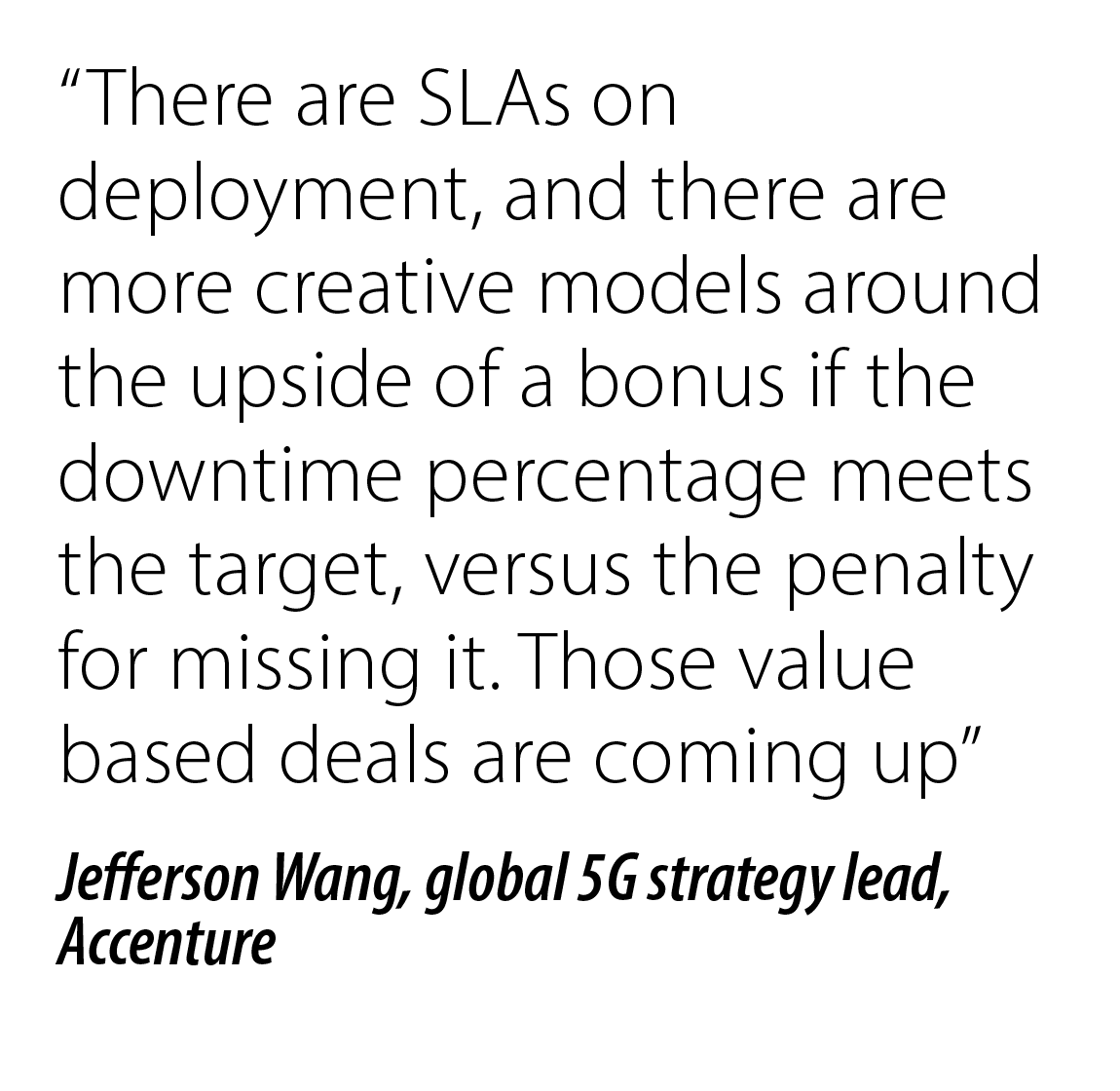This conversation will form part of the narrative in the forthcoming Enterprise IoT Insights report on industrial 5G SLAs, out at the start of April (to be available here). A webinar on the same subject is available here, with panellists from ABI Research, EXFO, Metaswitch (Microsoft), VoltDB and Zeetta Networks.
Accenture, a multinational professional services company with over 500,000 staff, is repeatedly cited in conversation as a primary candidate for the supply and management of industrial 5G networks, alongside the likes of IBM, CapGemini, Infosys, TechMahindra, and others. But it is presented as both a potential rival and companion for the traditional operator community in service of the Industry 4.0 dream. This is a fine balance for Accenture, as the below interview explains; it is positioned as a kind of ‘eminence grise’ in the Industry 4.0 game, incorporating industrial 5G as a key tactic.
The firm advises on digital change in just about every industrial discipline, including in telecoms, and takes charge at the same time of the new telecoms supply into them. But, as its recent deal with US carrier AT&T and US oil company Phillips 66, it can also play as king-maker for the operator set. Here, we talk with Jefferson Wang, the company’s global 5G strategy lead, about the shifting dynamic with industry/telecoms crossover, and the partnership roles and networking contracts that will underpin it.
…
Explain Accenture’s position on private LTE and 5G for enterprises. Because Accenture advises all kinds of businesses on digital transformation, including mobile operators. And yet LTE and 5G are a part of the new tech bundle being offered to drive Industry 4.0. So how does Accenture walk the line – between serving industry with telecoms, and helping telecoms to serve industry?
So, yes, it takes some thought to answer this. We work with the entire value chain. We have an entire industry group focused on communications, media, and technology (CMT), which includes helping mobile operators, including with the provision of private networks to enterprises. Because operators have a strong position on spectrum, and in the 3GPP standard process, but [they have a challenge to] break-in with these enterprises. That is one of the questions we have been helping with – how do they go from selling SIM cards at scale to helping these industrial companies.
At the same time, three quarters of our revenue comes from outside of the CMT business – from directly helping these industries to digitally transform. Take a manufacturing company, an oil and gas company, an energy company – we are always working with them anyway, with their back office and their cost reduction, and with their digital supply chain. So we are helping them with digital transformation, including how connectivity plays in that storyline.
So there are two parts to the value chain which meet in the middle. One is about the business case, which leads to predictive maintenance in manufacturing, for example. There, the discussion is about reduction, or growth, or safety. Which is traditional professional services consulting. [The other is about] the decomposition of those use cases, about the technologies required to make them happen – which gets into private cellular versus, and everything else. And we have always done that as well. [The difference now is] we cross-over with operators and vendors in the CMT space, if you will. That’s where the intersection happens.
So, there remain challenges for the carrier community, then, but opportunities as well? How are mobile operators doing with this, generally? How are they making the transition, to serve the industrial space with more entangled OT-enabling systems? What is your assessment of that?
They have an opportunity with private 5G networks and 5G slicing, even if slicing comes later, to grow-beyond [traditional mobile services]. Because 5G was built from the ground up for many-to-many [connectivity], where it used to be about one-to-many before. But this [discipline] around how to personalise a network for Company X requires different muscles, which the operator community is still developing. They have always sold devices on network plans to individuals, and the deals were just multiplied for enterprises – how many SIM cards, how much data, and it’s a rather straightforward transaction.

But this is different, now. Because the manufacturer comes with a particular problem, around safety and security, and whatever business processes. The service provider has to map the problem to the equipment in its toolbag, to be able to provide a solution each time. So the manufacturer has a problem with predictive maintenance on the plant, say, where the machines break down when they hit a certain vibration level, and the operator responds with a low-band LTE network that gets connectivity to the places that Wi-Fi didn’t.
But, then, the operator is faced with a problem with the sensors, where the wrong ones will spark and cause an explosion. So it needs to partner on devices, to build the right sensor, and it needs to partner for the application on top to bring all the data together, and figure out the tolerances and trends and benchmarks. Which is where a system integrator (SI) comes in – to build the solution. It doesn’t mean an operator can’t develop those skills; it just means for the sake of speed, partners will be recruited to fill certain roles. The value chain will take shape over time.
So who will manage the network in most cases – the enterprise, the operator, the system integrator, or a professional services company like Accenture? Clearly, this is a horses-for-courses kind of a question, but how should we rationalise the management side of industrial 5G?
Yes, there are a lot of options; it depends on the industry and the use case. A network operator is a good one, clearly, because it knows about running a network, and about spectrum; equipment providers are starting to offer help, as well [to carriers to manage networks]; and Accenture, in certain instances, has helped manage the network, or parts of it, like running the NOC, or helping with issue resolution and ticket triage out of the NOC alarms.
It comes down to figuring out the support systems behind the SLAs to make sure it is all buttoned-up, so any issues are resolved as quickly and securely as possible. There are lots of parts to the value chain, and pros and cons against each – going with an operator versus going with a vendor or an SI. Some will be more expensive, just because they have experience and robust tools; some may focus on other parts of the value chain.
It depends on what you’re trying to accomplish. Because I’ll tell you what; some of these private networks don’t need the most advanced operations. If you look at the use cases, they aren’t necessarily the gold-plated operations [you read about]. There is a job to make sure the network is secure and reliable, but you don’t always need the bells and whistles on top.
Just for example, the private network for Phillips 66 was about getting connectivity to go through the refinery campus. Because there was a lot of metal. [The use case was] enterprise mobility, for starters, around form-filling and workflow – which brings more productivity. And from a network management point of view, the site went from hundreds of Wi-Fi access points to a couple of [cellular] radios, which is a great simplification.
Indeed, presumably the narrative here – with open RAN and self optimising networks, and simplified core networks running just a handful of industrial cases – is the discipline of LTE and 5G network management gets simpler? To the point it becomes like managing an enterprise Wi-Fi network, which has been managed mostly in-house for yonks? In which case, do enterprises even need a third party for more than emergency issue resolution?
Yes, that’s the way to think about it. But you have to be monitoring, right, because the whole point of an industrial-grade private network, compared to best-effort Wi-Fi, is it is more reliable, and available, and secure. And managing a consumer-grade network for hundreds of millions of people is different to managing a fixed-perimeter network [with lower density and higher variability].
 A mining company is looking for communications above ground and below ground, which requires different networks – which are both very different to a utility company, say, which wants a field-area network for grid modernisation – which is geared for linear transmission, going tens of thousands of miles. That’s a different level of monitoring. And both those use cases – mining, above and underground, and linear comms for the energy sector – are totally different to consumer networks.
A mining company is looking for communications above ground and below ground, which requires different networks – which are both very different to a utility company, say, which wants a field-area network for grid modernisation – which is geared for linear transmission, going tens of thousands of miles. That’s a different level of monitoring. And both those use cases – mining, above and underground, and linear comms for the energy sector – are totally different to consumer networks.
Although we are working to simplify private networks in terms of their architecture, their reliability and security [is critical / complex]. That is the differentiator. So it does require operations, monitoring, issue resolution. But it is very different by industry, network, and use case.
You referenced it earlier, about this crossover between Accenture’s industry and telecoms practices. But talk about the need for the supply-side to collaborate in this Industry 4.0 market – on the grounds the technology is nascent, but also highly fragmented, and the applications are still novel, and the use cases are so varied.
Yes, absolutely. We used to solve all of this with mesh networks, using unlicensed spectrum. It has evolved, and now you have private networks and edge compute, and the chance to have full control. But a private network and edge compute with a local core is expensive. If you install a hybrid network, you might have less control, but it is easier to get started. It comes down to the use cases – the local traffic breakout, worker safety, worker location.
And then there are decisions to make, about whether to use mesh or Wi-Fi [instead], and how much you want to architect with this new [private cellular] option – whether to put a full core on-prem, or build a hybrid setup, or leverage the carriers’ capabilities. It requires a clear strategy and business case, and partnerships [to make it happen]. Because the SI part, to orchestrate all of this together, is a job in itself.
And what about the sense that, as it stands, most of this stuff is on LTE still, and it is only doing what Wi-Fi can’t do? That the big dream of Industry 4.0, which comes with URLLC-style 5G, is a while off, yet? Is that fair? Or would you suggest that critical comms are running on LTE, already, with SLAs around network performance and availability? The subtext, here, is there is not much going on, actually, when it comes to writing SLAs for private cellular networks. What do you make of that?
But private 4G is incredibly powerful, already. It depends, again, on the industry and the use case. But you look at field-area networks for energy and utilities, and how many hundreds of thousands of miles are being connected and monitored [with LTE]. You know, Texas in the US has its own grid, right? There is an east grid and west grid in the US, and somehow Texas got its own. And there is snow and real cold, and big issues for the grid there. We have seen that, recently, right?
You can’t solve any of that with Wi-Fi today. By the time you’ve meshed it out, it is just not an effective solution. We don’t think about these things; we think about latency, which can be 10-times lower with 5G – which makes 4G uninteresting for some industries. But for others, 4G by itself is game-changing. Because you can’t daisy-chain a mesh network to go for tens of thousands of miles, and solve it all without a number of hops.
You can do your best, but 4G really changes things, just for modernisation of the energy grid – where you draw coverage in lines, and not in circles, and go for thousands of miles. So 4G is transformative in itself. Upgrade to 5G, and your core network does slicing and low latency, and your radio and transport allow more devices per square kilometre – getting to that million figure. At that point, you add new use cases, and define different SLAs for the equipment and the value chain.
So what kinds of SLAs are going into those private LTE networks for critical comms, and what kinds of SLAs will go against future URLLC networks? It is, of course, an impossible question, to an extent, because it depends on use cases and sectors. But, again, how should we rationalise this stuff?
Yes, I don’t think the way to think about this is to define specific SLAs, just because it changes by case, by industry, by company. I mean, how much was Southern California Edison planning to spend [on insulated power lines] to reduce exposure to wildfires? $582 million. [Instead, it has decided to install and connect] cameras to monitor the power lines, so it knows where to remove vegetation to stop the fire risk.
So the SLA is not just about running at five-nines, which is important, but about the value of the use case – which is something, in the case of monitoring vegetation, that Wi-Fi couldn’t support. Private LTE gets you the connectivity, and then you build new use cases on top of it – like for vegetation management with cameras or dones. There are core network SLAs to think about, always, but it is when you get to the use-case SLA that the real value is created.
So, is it wrong to think that network management SLAs will be linked to network performance, actually? That performance is written about the technology, itself, into the design consultancy and the procurement contract, and that the SLAs about managed services and support are just about how quickly you pick up the phone? That no service provider is going to write into a contract that they will guarantee performance and reliability?
There’s a lot being written [in contracts] around automation in the network; that is an absolute given at this point. But, again, it goes case-by-case, and company-by company. It is often about how creative the company wants to be – so SLAs about a percentage-less downtime on equipment. There are SLAs on deployment, like you mentioned; and then there are these more creative models around the upside of a bonus if the downtime percentage meets the target, versus the penalty for missing it. Those value based deals are coming up
That seems like an IoT way of thinking, about how to calculate (and justify) these softer returns – which it has taken a long time for the traditional IoT market to come to. Just expand on the idea of more creative SLAs, and how much that trend is in evidence now.
We are starting to come out of pilot phase with lots of projects. There will be a natural evolution where both sides become more creative about this. As enterprises look for more ways of value-exchange, and even demand ways of value-exchange, and as the deals become larger and more complex, so the creativity will increase to make the economics work – between the whole community of operators, vendors, and system integrators in support.

